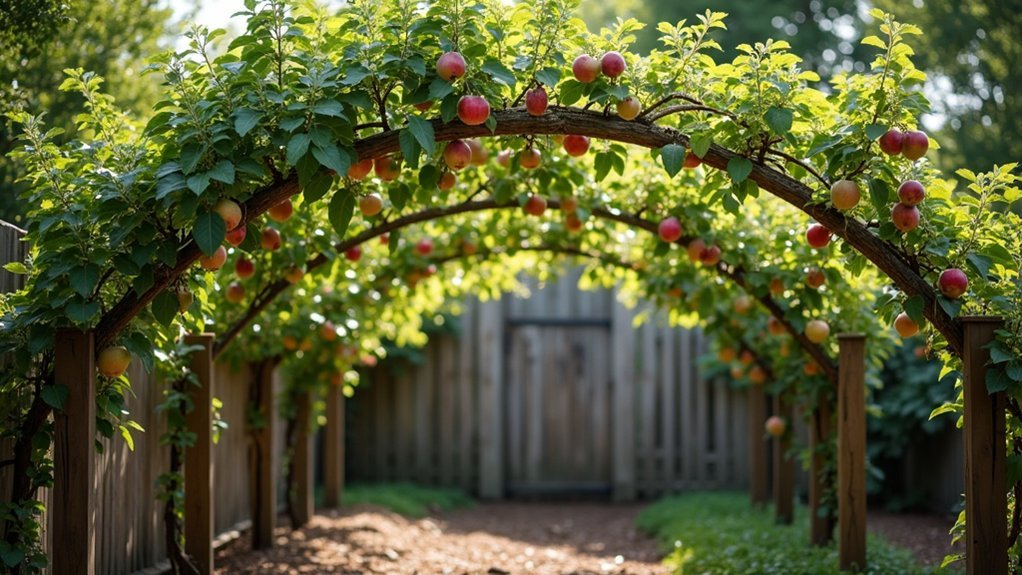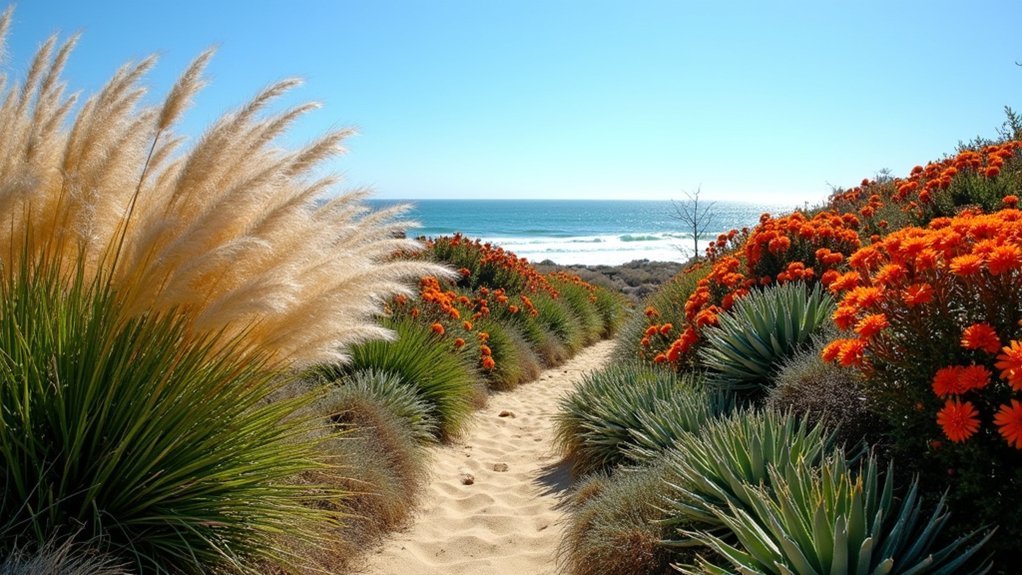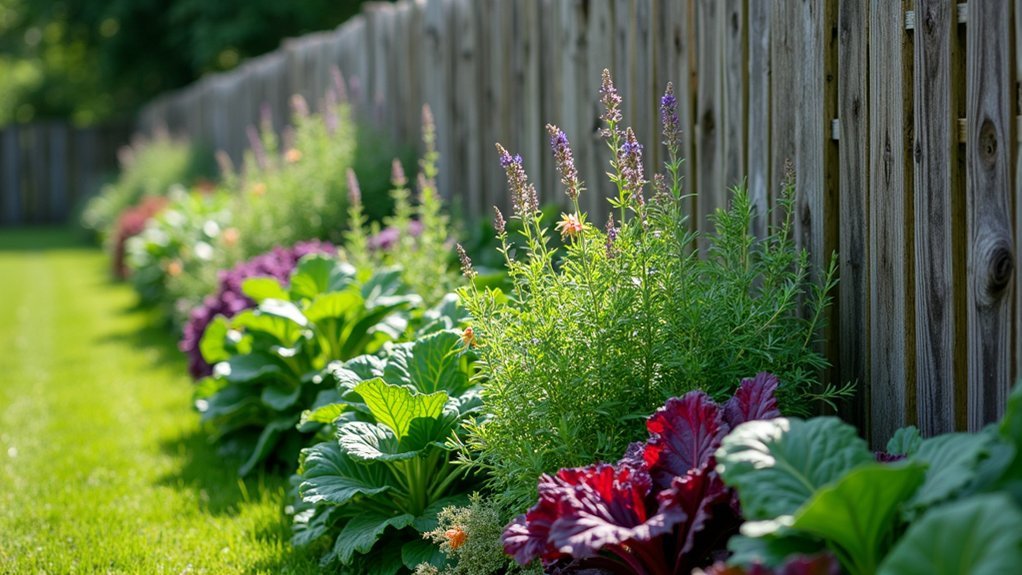Espalier fruit trees provide an elegant dual-purpose solution for your garden, creating natural privacy while producing seasonal harvests. You’ll need just 8 feet of sunny space per tree, with varieties like apples and pears working best. Regular pruning shapes these living sculptures into effective barriers reaching 6-8 feet tall. Beyond beauty and fruit, they improve biodiversity and air circulation in your landscape. The ancient technique offers surprising benefits that transform ordinary boundaries into productive garden features.
The Art of Espalier: Ancient Technique for Modern Gardens

How often do we encounter gardening techniques that seamlessly blend artistry with practicality? Espalier is exactly that—a horticultural method dating back to ancient Egypt and perfected in 17th century Europe that transforms fruit trees into living sculptures.
You’ll find this technique particularly effective with apples and pears, whose flexible branches can be trained into elegant horizontal branches against walls or structures.
By training trees to grow flat, you’re not just creating visual interest but maximizing fruit production in limited space.
Your espaliered fruit trees need about 8 feet of linear space and full sun exposure to thrive.
With regular maintenance—monthly minor pruning and annual major pruning in late winter—you’ll master this tree training technique that turns ordinary garden spaces into functional art while providing natural shade.
Why Choose Espalier Trees as Living Fence Barriers
You’ll gain a remarkable space-efficient privacy solution when you train fruit trees into an espalier fence, creating natural boundaries that occupy minimal ground area while reaching heights of 6-8 feet.
Your garden’s perimeter transforms into a productive beauty barrier that yields seasonal fruits while enhancing your landscape’s aesthetic value.
The structured framework not only provides effective screening but also contributes to local biodiversity, improving air circulation and offering habitat for beneficial wildlife that can increase your property’s appeal.
Space-Efficient Privacy Solution
While traditional fences consume valuable garden space, espalier fruit trees offer a stunning alternative that serves dual purposes.
You’ll create an elegant privacy barrier while maximizing your garden’s productivity in limited areas. These trained trees thrive against walls or fences, reaching heights up to 8 feet while requiring minimal horizontal space.
- Vertical advantage – Espalier trees grow upward rather than outward, perfect for narrow plots where conventional fencing would sacrifice precious growing area.
- Dual functionality – Enjoy both privacy and fruit production from the same plants, making every square foot of your garden work harder.
- Improved growing conditions – The structured training of espalier trees promotes better air circulation and sunlight exposure, resulting in healthier plants and superior fruit quality.
Productive Beauty Barrier
Beyond their space-saving design, espalier fruit trees transform ordinary boundaries into spectacular living sculptures that serve multiple functions in your garden.
These trained trees create visually striking barriers while producing bountiful harvests right at your fingertips.
When you train espaliered trees against a wall or trellis, you’re combining practicality with garden aesthetics. Their flat-growing patterns showcase artistic designs that screen unsightly views while allowing maximum sunlight exposure for fruit production.
You’ll appreciate how these living fences enhance air circulation, promoting healthier trees and better yields.
Embracing this technique exemplifies sustainable gardening at its finest. Your espaliered boundary provides food, creates wildlife habitat, and beautifies your space simultaneously.
Best Fruit Tree Varieties for Espalier Shade Fences

The perfect espalier shade fence begins with selecting the right fruit tree varieties that combine functionality with beauty.
Apple and pear trees stand out as premier choices—’Red Falstaff’ apples and ‘Conference’ pears develop short fruiting spurs that work beautifully when trained against a support structure.
For your espalier fruit trees, consider these outstanding options:
- Apple varieties like ‘Red Falstaff’ – Spur-bearing types that produce abundant fruit while forming an attractive shade fence
- Pear cultivars such as ‘Concorde’ – Adapt to various climates while creating elegant trained trees
- Peach, fig, and pomegranate trees – Offer unique benefits from fragrant blooms to sweet fruits while providing effective shade
You’ll find these trained trees deliver both practical shade and seasonal harvests, transforming ordinary boundaries into productive living fences.
Planning Your Espalier Fence: Layout and Design Considerations
When planning your espalier fence, you’ll need to select a sunny location with at least six hours of daily light and allocate roughly 8 feet per tree with proper spacing from your support structure.
Your design choice—whether Formal Fan, Horizontal Cordon, or Candelabra—will influence both the visual impact and long-term maintenance requirements of your living fence.
Installing robust support systems with heavy gauge wire and eyebolts is essential to guide branch development and guarantee your selected fruit tree varieties thrive in their carefully trained forms.
Space and Orientation Planning
Successful espalier fences begin with thoughtful space and orientation planning. Your espalier design requires at least 8 feet of linear space to accommodate tree growth and guarantee proper development.
Position trees 6-8 inches away from walls to promote healthy growth through improved air circulation, reducing the risk of disease.
Orientation plays an essential role in your espalier’s success:
- Choose south or west-facing locations to maximize the six hours of direct sunlight needed daily.
- Assess your space carefully, making certain the selected area provides adequate growing room for mature trees.
- Install sturdy wire supports or trellises that will guide branches while maintaining structural integrity as trees develop.
Remember that different fruit trees respond uniquely to espalier training—apple and pear varieties typically offer more flexible branches that adapt well to your chosen patterns.
Tree Variety Selection
Tree variety selection forms the foundation of your espalier fence project, determining both the visual appeal and fruit production potential.
When choosing trees, prioritize varieties with flexible branches that adapt well to training techniques. Apple or pear trees are excellent choices, as they combine pliability with abundant harvests.
Allow at least 8 feet of space per tree to guarantee proper development and air circulation.
Your selected espalier pattern—whether formal fan or horizontal cordon—will guide your training approach and spacing requirements.
For a dynamic landscape, mix fruit-bearing trees with ornamental options like crab apples or pyracantha. This combination provides visual interest across seasons while maintaining functionality.
Remember that regardless of variety, all trees need at least six hours of full sun daily for ideal growth and fruit production.
Support Structure Design
Creating a robust support structure serves as the backbone of any successful espalier fence project.
When designing your espalier tree installation, verify you have at least 8 feet of linear space for proper growth and visual appeal. Position trees 6-8 inches from walls to promote air circulation and prevent disease.
For effective training and maintaining the desired shape of your espalier tree, you’ll need:
- Heavy-gauge wire that won’t sag under the weight of fruit-laden branches
- Securely installed eyebolts to anchor your support structures at strategic points
- A clearly marked layout with vertical and horizontal lines for guidance
Consider implementing a tiered design like a three-tier cordon or formal fan pattern—these maximize both aesthetics and productivity while creating natural shade and privacy for your garden space.
Required Materials and Tools for Espalier Fence Construction
Building an effective espalier fence requires specific materials and tools to guarantee your fruit trees grow properly against the support structure.
You’ll need heavy gauge wire to create horizontal training lines and eyebolts or wall mounts to secure them. Wooden posts or metal stakes provide the necessary framework, especially if you’re not attaching to an existing wall.
For the actual training process, arm yourself with clean, sharp secateurs for precise pruning and a measuring tape to verify consistent spacing.
Don’t forget plant ties—3-ply jute twine works well for flexibility, while stainless steel cabling offers long-term durability. You’ll also need spacers to maintain distance between the wire and branches, and a drill for installing your support system securely.
Replace ties regularly as branches thicken to maintain your design.
Step-by-Step Guide to Planting Your Espalier Fruit Trees

Setting up your espalier fruit trees requires specific tools, proper site preparation, and specialized planting techniques to guarantee success.
You’ll need basics like a spade, pruning shears, and plant ties, alongside careful soil amendment to create the ideal growing environment.
After preparing your site with rich, well-draining soil and installing your support structure, position your young trees carefully—spacing them 6-8 feet apart with the graft union 2-3 inches above soil level.
Tools & Materials Needed
When you commence planting espalier fruit trees, you’ll need to gather several essential tools and materials before breaking ground. Proper equipment guarantees successful training and healthy growth of your living fence.
- Basic planting tools: Sharp secateurs for pruning, a spade for digging, and measuring tape to guarantee proper spacing from your support structure (about 6-8 inches for ideal air circulation).
- Support materials: Sturdy stakes or trellis systems that will bear the weight of your mature trees while providing the framework for horizontal branch training.
- Attachment supplies: Soft plant ties or jute to secure your tree without damaging the trunk, allowing natural growth while maintaining the desired espalier form.
Regular monitoring with these tools will help maintain your espalier’s shape and encourage the horizontal branching pattern that makes these trees so distinctive.
Site Preparation Process
Now that you’ve assembled your tools, proper site preparation forms the foundation for successful espalier fruit trees.
Begin by selecting a well-drained location with full sun exposure—at least six hours daily is ideal for robust growth.
Loosen soil to 12-18 inches deep, removing rocks and weeds before incorporating organic matter like compost to enhance fertility and drainage.
Mark appropriate spacing, allowing 8 feet of linear space per tree. Position trees 6-8 inches from your supporting structure.
Dig holes twice as wide as each root ball but maintain the same depth. Place trees at their original nursery depth, then backfill with amended soil.
Water thoroughly, providing about a gallon every 7-10 days until established. Apply fruit tree fertilizer during growing season to support healthy development.
Planting Techniques Explained
The success of your espalier fruit tree depends largely on proper planting techniques that establish a strong foundation for future growth.
Begin by digging a hole twice as wide as the root ball in your chosen well-drained area with full sun exposure. Position your fruit tree carefully, ensuring the trunk aligns with your vertical support system.
- Secure the foundation – After planting, immediately attach the main trunk to your vertical wire using soft garden ties, being careful not to damage the bark.
- Implement initial pruning – Remove any branches that don’t fit your espalier design, focusing on maintaining horizontal branches.
- Establish watering routine – Provide approximately one gallon of water every 7-10 days until your espalier fruit trees become established.
Regular pruning and tying of new growth will train your espalier into the desired pattern over time.
Training Techniques for Creating the Perfect Living Fence

Transforming ordinary fruit trees into elegant living fences requires specialized training techniques that balance both form and function. When working with espaliered fruit, select varieties like apple trees that have naturally flexible branches amenable to horizontal branching patterns.
Install heavy gauge wire supports that can bear the weight of your growing trees, ensuring they’re securely fastened to your wall or fence. As branches develop, carefully tie them to your framework at consistent intervals, pruning excess growth to maintain your desired shape.
Don’t forget to use spacers between branches and the support structure to promote good air circulation, reducing disease risk.
Regularly check and adjust ties as your trees mature to prevent constriction. With patience and consistent attention, your living fence will provide both beauty and functionality for years to come.
Seasonal Pruning and Maintenance for Espalier Fences
Successful espaliered fruit trees require consistent seasonal maintenance to preserve their architectural beauty while guaranteeing abundant harvests. Your primary pruning should occur in late winter to early spring, establishing the framework before branches grow during the active season.
The artistry of espaliered trees demands regular attention, rewarding the diligent gardener with both visual elegance and bountiful yield.
Throughout the year, perform monthly minor trimmings to maintain shape and encourage horizontal development.
- Perform seasonal pruning by nipping back new growth to maintain uniformity and improve air circulation to prevent disease.
- Remove and adjust ties as branches grow and mature to prevent damage and accommodate expanding limbs.
- Focus on monitoring the structure monthly, making necessary adjustments to supports that guarantee your living fence maintains its intended design.
Proper maintenance isn’t just about aesthetics—it’s essential for healthy fruit production and guaranteeing your espalier remains a stunning landscape feature for years to come.
Maximizing Fruit Production While Maintaining Shade Coverage

While creating a beautiful garden feature, espalier fruit trees excel at the dual purpose of providing both abundant harvests and practical shade coverage when strategically positioned. You’ll need to balance pruning techniques with your desired shade level to maximize fruit production without compromising either function.
| Espalier Forms | Fruit Production | Shade Coverage |
|---|---|---|
| Horizontal Cordon | High yield, easy harvest | Moderate, evenly distributed |
| Fan | Maximum sunlight exposure | Dense, wide coverage |
| Belgian Fence | Good air circulation | Filtered, decorative pattern |
| Candelabra | Vertical growth emphasis | Tall coverage, less width |
Choose deciduous fruit trees for seasonal benefits—summer shade with winter sun penetration. Regular pruning maintains the espalier form while ensuring branches don’t become overcrowded, allowing sufficient light to reach developing fruits. This balanced approach creates productive, beautiful living fences.
Pest and Disease Management for Espalier Fruit Fences
Because espalier fruit trees grow in a restricted, condensed form, they can be particularly vulnerable to pest infestations and disease outbreaks that spread quickly across the structure.
Regular inspection is your first line of defense against common threats like aphids, spider mites, and fungal diseases.
Vigilant monitoring reveals pest problems before they become infestations, keeping your espalier trees healthy and productive.
Maintaining tree health requires a proactive approach:
- Implement integrated pest management by introducing beneficial insects like ladybugs, reducing dependency on chemical treatments while effectively controlling pests.
- Practice routine pruning to improve air circulation, preventing humidity-loving diseases such as powdery mildew and canker.
- Apply organic treatments like neem oil according to package instructions, and keep the base of trees clear of debris and fallen fruit.
These practices will help safeguard your espalier fruit fence while minimizing environmental impact.
Combining Different Fruit Tree Varieties in Your Living Fence
Beyond pest management, the artistry of espalier truly blossoms when you combine different fruit tree varieties in a single living fence.
By integrating apple, pear, and peach trees into your espalier design, you’ll create a stunning barrier that produces diverse fruits throughout the season.
For ideal results, pair self-fertile varieties like ‘Red Falstaff’ apple with ‘Conference’ pear to guarantee cross-pollination and maximize harvests.
Arrange your trees in tiers or decorative patterns that provide both structure and privacy in compact spaces.
Consider adding ornamental crab apples alongside sweet cherries for enhanced visual appeal during different seasons. The combination creates a living fence that’s both functional and beautiful.
Regular pruning maintains the espalier’s shape, ensuring your fruit tree collection continues to thrive and produce for years to come.
Real-World Examples: Successful Espalier Shade Fences in Various Climates
As gardeners across diverse climate zones have discovered, espalier fruit trees serve as exceptional living shade fences that combine beauty with functionality.
These creative solutions maximize fruit production while utilizing small spaces effectively.
Espalier techniques transform ordinary boundaries into productive living art, where every inch serves both beauty and bounty.
- In the Pacific Northwest, homeowners have transformed outdoor seating areas with espaliered apple trees against fences, providing shade and accessible fruit harvesting.
- Southern California residents enjoy year-round benefits from espaliered citrus trees that create fragrant, productive shade boundaries around properties.
- Urban gardeners have reclaimed narrow pathways with espaliered peach and cherry trees, establishing privacy screens that yield seasonal harvests.
You’ll find these living shade fences in both residential yards and community gardens, offering sustainable alternatives to traditional fencing while enhancing aesthetics and improving air circulation—perfect for any gardener looking to maximize both space and productivity.
Frequently Asked Questions
How Much Sun Does Espalier Need?
Your espalier trees need at least six hours of direct sunlight daily for ideal growth and fruit production. You’ll want to position them against south-facing walls where they’ll receive maximum sun exposure for best results.
What Is the Best Support for Espalier Trees?
The best support for espalier trees includes sturdy walls, fences, or trellises made from wood or metal. You’ll need heavy gauge wire, eye hooks, and spacers to properly train branches while preventing bark damage.
What Can I Put Around Fruit Trees to Keep Weeds Away?
You can apply a 3-4 inch layer of organic mulch like wood chips around your fruit trees. Add landscape fabric underneath for extra protection. Alternatively, plant ground covers like clover that naturally suppress weeds.
What Is the Best Fruit Tree for Shade?
Apple and pear trees are your best options for shade, as they grow tall with wide canopies. You’ll also get good results from fig and plum trees that offer dense foliage while producing delicious fruit.
In Summary
You’ve now discovered how espalier fruit trees can transform your property into a productive, beautiful living fence. With proper planning, you’ll enjoy shade, privacy, and fresh harvests for years to come. Don’t let space constraints limit your gardening dreams – espaliered trees work in virtually any climate and location. Start small, be patient with the training process, and you’ll master this ancient technique while creating a truly unique landscape feature.





Leave a Reply